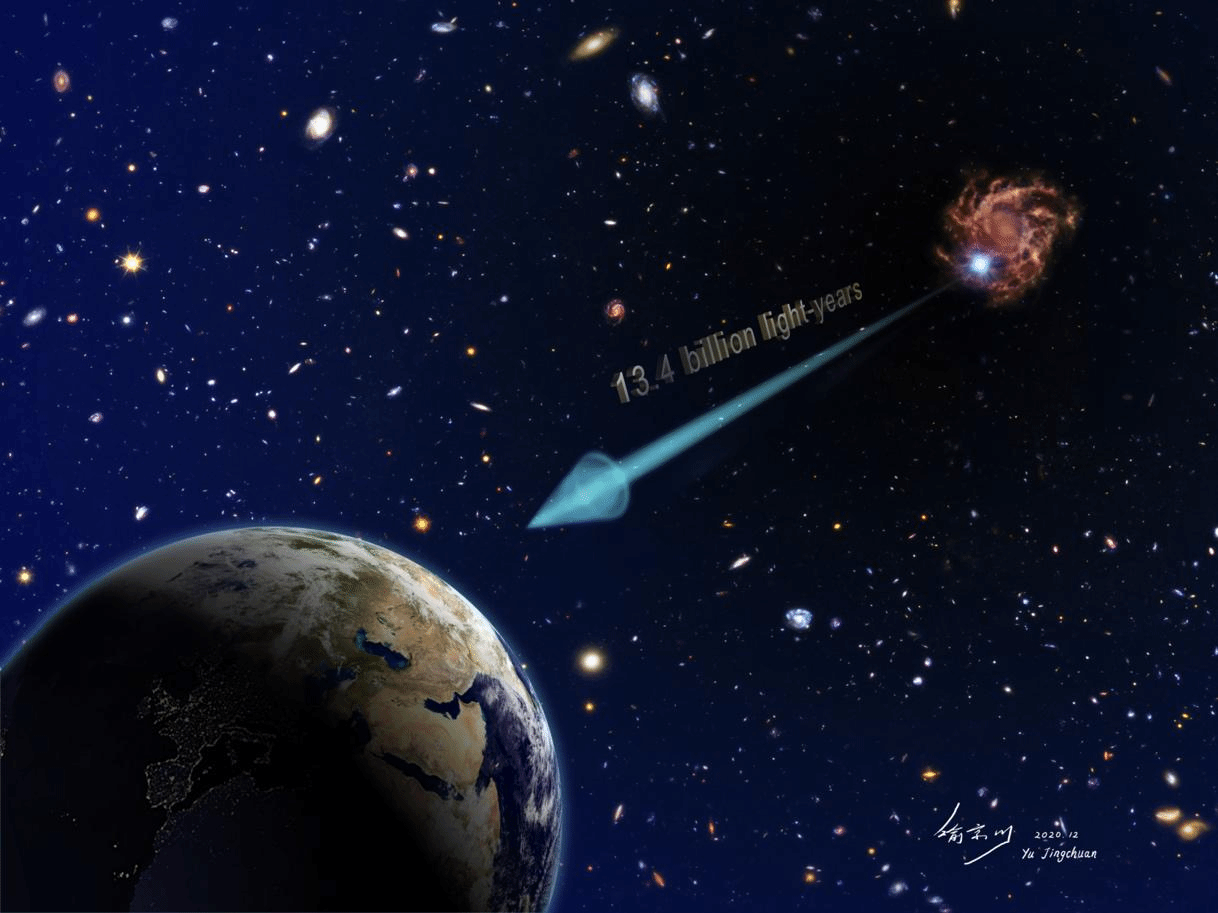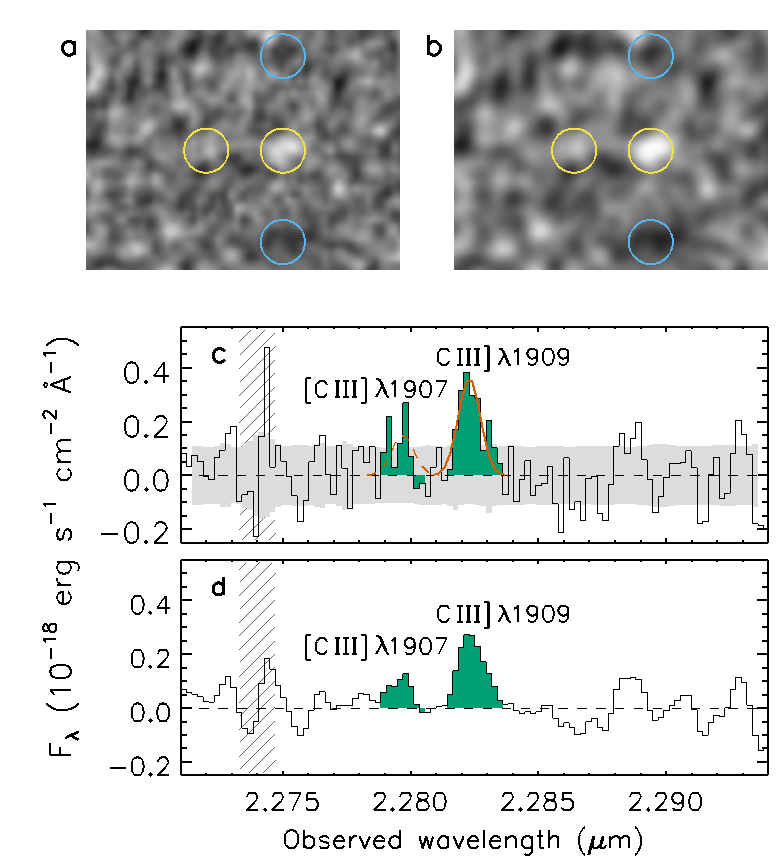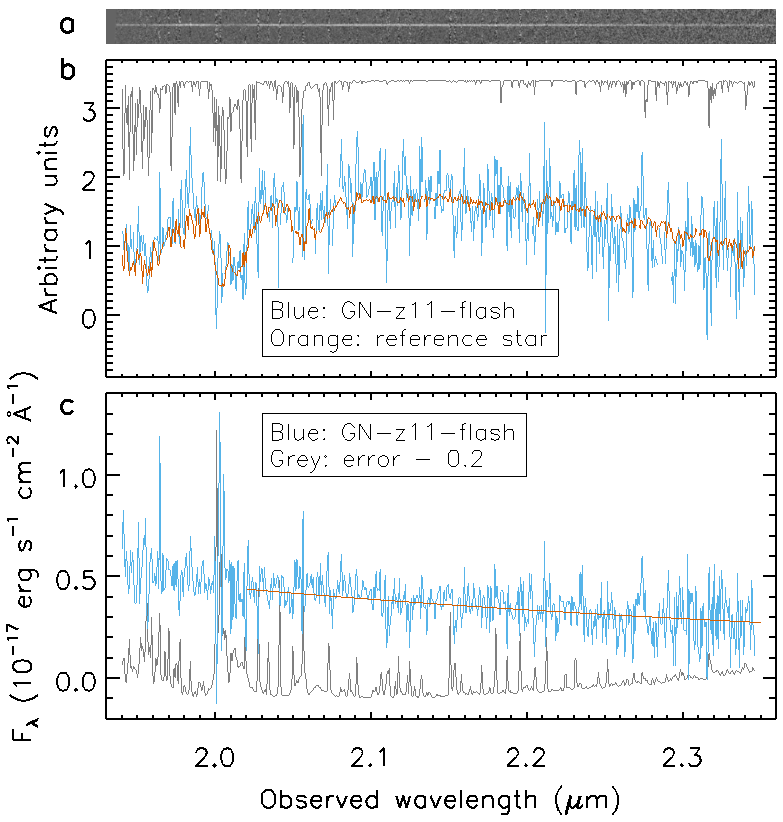An international team of astronomers, led by Professor Linhua Jiang at the Kavli Institute for Astronomy and Astrophysics at Peking University, obtained near-infrared spectra and successfully measured the redshift of a very faint galaxy 13.4 billion light-years away, the most distant astrophysical object known to date. Meanwhile, the team also detected a burst signal with a duration of minutes from the galaxy, which can be explained as an ultraviolet flash associated with a gamma-ray burst (GRB). These results are important to understand the formation of stars and galaxies in the very early Universe (Figure 1). Two papers based on the results were recently published in Nature Astronomy.

Figure 1. An artist’s conception of the most distant galaxy with a Gamma-ray burst (credit: Jingchuan Yu).
Based on current theory and cosmological simulations, the Universe experienced an era of so-called “cosmic dark age” shortly after the Big Bang. At the end of the dark age, cosmic large-scale structures started to form, resulting in the birth of the first-generation stars and galaxies. The first stars formed about 150 million years after the Big Bang, and the first galaxies formed roughly 100 million years later. This is also the epoch when the seeds of the first supermassive black holes started to form and grow. These astrophysical objects gradually re-ionized the Universe. This “cosmic reionization” lasted several hundred million years and represents one of the most important phase transitions of the Universe. One of the main scientific goals of the next generation telescopes is to understand cosmic reionization and detect light from the first objects. But for current astronomical facilities, it is very difficult to detect optical/infrared spectra from such distant galaxies.
Using one of the largest optical/infrared telescopes, the 10m Keck I telescope on Mauna Kea, Hawaii, Jiang’s team carried out deep spectroscopic observations of the galaxy “GN-z11” in the near-infrared. Based on existing data from the Hubble Space Telescope, GN-z11 is generally believed to be a very distant galaxy at a redshift around 11, or at least greater than 10. But its accurate redshift has remained unclear. From the high-quality spectra obtained from Keck, the team detected three emission lines from GN-z11 and determined a redshift 10.957, meaning that GN-z11 is a galaxy with a distance of 13.4 billion light-years (Figure 2). This is the most distant astrophysical object known to date. The three emission lines are produced by gas with doubly ionized carbon and oxygen, suggesting a high metal abundance (elements other than hydrogen and helium) in this galaxy. It further means that GN-z11 is not one of the first-generation galaxies, which would contain almost no metals.

Figure 2. Keck near-infrared spectra of GN-z11. Panels (a) and (c) show the 2D and 1D spectra, respectively; panels (b) and (d) show the smoothed version of the 2D and 1D spectra. The doubly ionized carbon emission lines at rest-frame ~191 nm have shifted to about 2283 nm in the observed frame, indicating a redshift 10.957.
During their spectroscopic observations on Keck, the team members also serendipitously caught a bright burst from GN-z11. This burst (hereinafter GN-z11-flash) showed up as a compact continuum spectrum in one image with a duration shorter than 3 minutes (Figure 3). The spectrum exhibits prominent telluric absorption features, indicating that GN-z11-flash arose from above the atmosphere. The team members performed a comprehensive analysis of the origin of GN-z11-flash, and ruled out the possibility that the flash was from any known sources such as man-made satellites or moving objects in the Solar system. They concluded that GN-z11-flash was likely produced by a GRB in GN-z11, as the spectrum, brightness, and duration of the flash are consistent with such an interpretation. Although the chance probability of being a GRB is very low, it is still two orders of magnitude higher than the probability of being any other known sources. This result may imply that GRBs can be produced as early as 400 million years after the Big Bang.

Figure 3. Spectra of the burst GN-z11-flash. Panel (a) shows its 2D spectrum, panel (b) the 1D spectrum (blue) extracted from (a), and panel (c) the fully calibrated spectrum (blue).
The above results suggest that the largest telescopes currently available are capable of detecting near-infrared spectra from some of the brightest galaxies at high redshift. Future infrared facilities will be able to find the progenitors of GN-z11-like galaxies and even the first galaxies. The next generation GRB detectors will directly detect GRBs from the very distant Universe.
This work was supported by the National Science Foundation of China, the National Key R&D Program of China, and the CAS South America Center for Astronomy.
Links to the two papers:
1. Evidence for GN-z11 as a luminous galaxy at redshift 10.957(DOI: 10.1038/s41550-020-01275-y)
2. A possible bright ultraviolet flash from a galaxy at redshift ≈ 11 (DOI: 10.1038/s41550-020-01266-z)